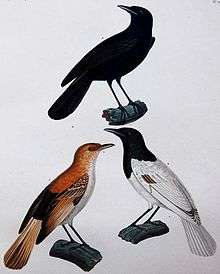Pomarea
Pomarea is a genus of birds in the monarch flycatcher family Monarchidae. The genus is restricted to the islands of Polynesia. The monarchs of this genus are around 15–19 cm long and most have sexually dimorphic plumage.
| Pomarea | |
|---|---|
 | |
| Scientific classification | |
| Kingdom: | Animalia |
| Phylum: | Chordata |
| Class: | Aves |
| Order: | Passeriformes |
| Family: | Monarchidae |
| Genus: | Pomarea Bonaparte, 1854 |
Taxonomy and systematics
Extant species
The genus Pomarea contains six extant species, including one possible extinct:[1]
- Rarotonga monarch (Pomarea dimidiata)
- Tahiti monarch (Pomarea nigra)
- Marquesan monarch (Pomarea mendozae)
- Ua Pou monarch (Pomarea mira) (Possibly extinct)
- Iphis monarch (Pomarea iphis)
- Fatu Hiva monarch (Pomarea whitneyi)
Extinct species
- †Maupiti monarch (Pomarea maupitiensis)
- †Nuku Hiva monarch (Pomarea nukuhivae)
- †Eiao monarch (Pomarea fluxa)
Former species
Formerly, some authorities also considered the following species (or subspecies) as species within the genus Pomarea:
- Bougainville monarch (as Pomarea erythrosticta)[2]
- Chestnut-bellied monarch (ugiensis) (as Pomarea ugiensis)[3]
Status
The genus is highly threatened, with three of the six remaining species listed as critically endangered, one endangered and two vulnerable. Three species have already become extinct. The principal threat to all these species is predation by the introduced black rat.
gollark: Rock Crusher, people!
gollark: Down with Draconic Evolution!
gollark: I have a 32-interface cube because I have *a lot of recipes*.
gollark: I mean, I don't find combat very fun anyway, so meh.
gollark: Alternatively, fork the mod and change two lines of code or so!
References
- "Monarchs « IOC World Bird List". www.worldbirdnames.org. Retrieved 2017-01-01.
- "Monarcha erythrostictus - Avibase". avibase.bsc-eoc.org. Retrieved 2017-01-19.
- "Monarcha ugiensis ugiensis - Avibase". avibase.bsc-eoc.org. Retrieved 2017-01-20.
This article is issued from Wikipedia. The text is licensed under Creative Commons - Attribution - Sharealike. Additional terms may apply for the media files.